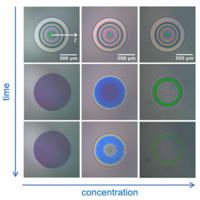当前位置:
X-MOL 学术
›
Phys. Rev. Fluids
›
论文详情
Our official English website, www.x-mol.net, welcomes your feedback! (Note: you will need to create a separate account there.)
Evaporation-driven solutocapillary flow of thin liquid films over curved substrates
Physical Review Fluids ( IF 2.5 ) Pub Date : 2019-03-13 , DOI: 10.1103/physrevfluids.4.034002 Mariana Rodríguez-Hakim , Joseph M. Barakat , Xingyi Shi , Eric S. G. Shaqfeh , Gerald G. Fuller
Physical Review Fluids ( IF 2.5 ) Pub Date : 2019-03-13 , DOI: 10.1103/physrevfluids.4.034002 Mariana Rodríguez-Hakim , Joseph M. Barakat , Xingyi Shi , Eric S. G. Shaqfeh , Gerald G. Fuller

|
Evaporative loss of a volatile solvent can induce concentration inhomogeneities that give rise to spatial gradients in surface tension and subsequent solutocapillary Marangoni flows. This phenomenon is studied in the context of ultrathin liquid films resting atop curved convex substrates in contact with a fluid reservoir. Experiments are conducted with low-molecular-weight polydimethylsiloxane (silicone oil) mixtures composed of a volatile solvent and trace amounts of a nonvolatile solute. A theoretical model based on the thin-film approximation is developed, incorporating the effects of evaporative mass loss, gravity, capillarity, van der Waals forces, species diffusion, and Marangoni stresses. The spatiotemporal evolution of this system is studied by modulating the rate of evaporation of the volatile species and the bulk solute volume fraction in the mixture. The experiments and accompanying numerical simulations reveal that both Marangoni stresses and stabilizing van der Waals interactions between the substrate and the free surface can induce flow reversal and film regeneration. Their relative contribution is modulated by the solutocapillary Marangoni number, which is proportional to the bulk concentration of nonvolatile species in the mixture. Furthermore, it is revealed that increasing the rate of evaporation enhances the volumetric flow rate from thicker, solvent-rich areas towards thinner, solute-rich regions of the film. Although quantitative differences between the theory and the experiments are observed within certain ranges of the controlled parameters, the model qualitatively reproduces the flow regimes observed in the experiments and elucidates the complex interplay among the various physical forces.
中文翻译:

蒸发驱动的液体薄膜在弯曲基板上的溶质毛细管流动
挥发性溶剂的蒸发损失会引起浓度不均匀性,从而引起表面张力的空间梯度以及随后的溶质毛细管Marangoni流动。在超薄液膜搁置在弯曲的凸形基板上并与储液器接触的情况下,对这种现象进行了研究。使用由挥发性溶剂和痕量非挥发性溶质组成的低分子量聚二甲基硅氧烷(硅油)混合物进行实验。建立了基于薄膜近似的理论模型,该模型综合了蒸发质量损失,重力,毛细管现象,范德华力,物质扩散和马兰戈尼应力的影响。通过调节混合物中挥发性物质的蒸发速率和总溶质体积分数,研究了该系统的时空演化。实验和随附的数值模拟表明,基材和自由表面之间的Marangoni应力和稳定的范德华相互作用都可以引起逆流和薄膜再生。它们的相对贡献由溶质毛细血管的马兰哥尼数调节,该数与混合物中非挥发性物质的总体浓度成正比。此外,揭示了增加蒸发速率可提高从膜的较厚的,富溶剂的区域向较薄的,富于溶质的区域的体积流速。
更新日期:2019-03-14
中文翻译:

蒸发驱动的液体薄膜在弯曲基板上的溶质毛细管流动
挥发性溶剂的蒸发损失会引起浓度不均匀性,从而引起表面张力的空间梯度以及随后的溶质毛细管Marangoni流动。在超薄液膜搁置在弯曲的凸形基板上并与储液器接触的情况下,对这种现象进行了研究。使用由挥发性溶剂和痕量非挥发性溶质组成的低分子量聚二甲基硅氧烷(硅油)混合物进行实验。建立了基于薄膜近似的理论模型,该模型综合了蒸发质量损失,重力,毛细管现象,范德华力,物质扩散和马兰戈尼应力的影响。通过调节混合物中挥发性物质的蒸发速率和总溶质体积分数,研究了该系统的时空演化。实验和随附的数值模拟表明,基材和自由表面之间的Marangoni应力和稳定的范德华相互作用都可以引起逆流和薄膜再生。它们的相对贡献由溶质毛细血管的马兰哥尼数调节,该数与混合物中非挥发性物质的总体浓度成正比。此外,揭示了增加蒸发速率可提高从膜的较厚的,富溶剂的区域向较薄的,富于溶质的区域的体积流速。





































 京公网安备 11010802027423号
京公网安备 11010802027423号